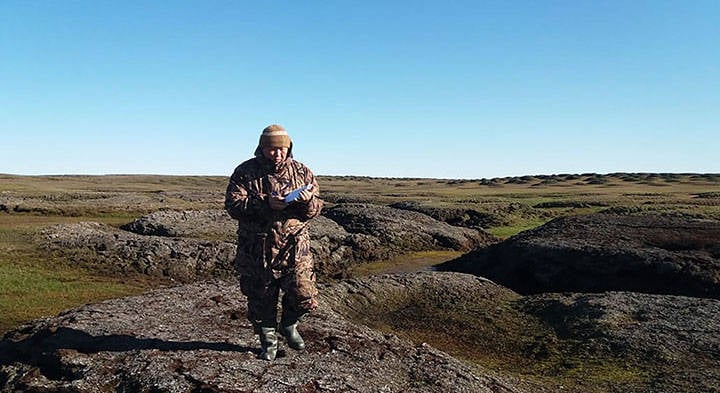Scientists believe this is an entirely new species of mammoth, the existence of which has never been demonstrated before.
Academy of Sciences of the Sakha RepublicThe pygmy mammoth was found perfectly preserved, buried beneath the ice of Kotelny Island in the Russian Arctic.
The scientists Mammutus exilisor whatever they call it “Golden Mammoth”Named for its strawberry-blonde fur color, the discovery of the remains proves the existence of a smaller, or “dwarf,” species of woolly mammoth, the like of which scientists have never seen before.
The “golden mammoth” fossil is about 2 meters (nearly 6 and a half feet) tall, making it very small compared to a typical woolly mammoth, which averages 3 meters (about 10 feet) tall.
The mammoth was discovered on Kotelny Island in Russia’s Siberian region, and although scientists had previously heard reports of smaller mammoths being found in the area, the discovery of this remains solidifies their existence.
Dr Albert Protopopov from the Yakutina Academy of Sciences said scientists had “received reports of dwarf mammoths, both adults and juveniles, being found in that particular area, but had never come across a carcass. This is the first opportunity to study it.”


Academy of Sciences of the Republic of SakhaDr. Protopopov works on Kotelny Island.
Scientists still need to determine whether this is a one-off discovery of the animal or if the mini-woolly mammoth is unique to the area where the remains were found.
The bones of what scientists believe to be a pygmy-sized woolly mammoth were discovered in the Russian Arctic, but Dr. Protopopov believes the “golden mammoth” is an entirely new species of pygmy mammoth, which he believes has roamed the Earth for a long time and is not an unusual species, but rather an evolutionary adaptation unique to the area where it was found.
Protopopov took part in the expedition to Kotelny Island, where the “golden mammoth” was discovered, together with a team of “paleontologists, archaeologists, zoologists, botanists, entomologists and permafrost experts.”
He said Siberian Times“We believe this mammoth may have lived during the height of its species’ popularity, which is thought to have occurred during the Karginsky Interglacial Period (50,000 to 22,000 years ago). Our theory is that this was the period when mammoth populations increased significantly and their morphological diversity was at its greatest, so we hope to test this theory.”
What makes this new woolly mammoth discovery even more intriguing is where it was found: Kotelny Island, and much of Russia’s Siberian Arctic, is completely frozen over in winter, including the ocean.


TASSTASS via Getty ImagesAn Arctic expedition conducted by the Russian Ministry of Defense to Kotelny Island.
The find is particularly remarkable because the mammoth was found in what Dr Protopopov describes as “an inaccessible location, almost completely buried beneath the earth in a tidal zone.”
Europe is experiencing its hottest summer on record, and it’s possible that these extreme temperatures melted the ice, making this discovery possible. It’s a discovery that has scientists very excited, and they’ve likely got the unusually hot summer of 2018 to thank for it.
Excavation of the “golden mammoth” is scheduled to begin in the summer of 2019, which could allow scientists to discover more well-preserved animals under the ice similar to this latest find.
Next, this kind of A frog that looks like a pigFind out how scientists are trying to bring extinct species back to life. Tasmanian Tiger is back.


